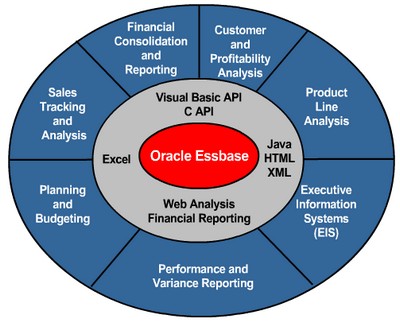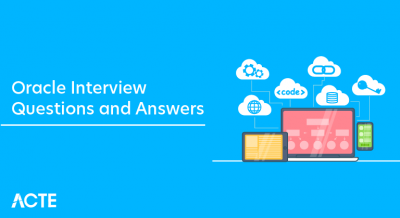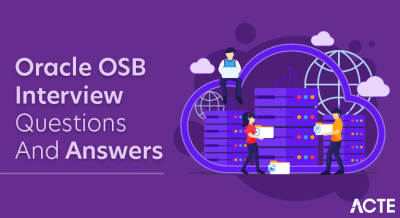
These Hyperion Interview Questions have been designed specially to get you acquainted with the nature of questions you may encounter during your interview for the subject of Hyperion. As per my experience good interviewers hardly plan to ask any particular question during your interview, normally questions start with some basic concept of the subject and later they continue based on further discussion and what you answer.we are going to cover top 100 Hyperion Interview questions along with their detailed answers. We will be covering Hyperion scenario based interview questions, Hyperion interview questions for freshers as well as Hyperion interview questions and answers for experienced.
1. What is Oracle Hyperion?
Ans:
- Oracle Hyperion is a business performance management suite.
- It includes applications for financial planning, budgeting, and strategic modeling.
- Acquired by Oracle, it enhances organizational financial processes.
- Aims to optimize performance management and decision-making.
2. Explain the key components of Oracle Hyperion Suite.
Ans:
- Facilitates budgeting, forecasting, and scenario planning.
- Integrates with other Hyperion modules for comprehensive financial management.
3. What is the purpose of Hyperion Planning?
Ans:
- Enables organizations to create detailed financial plans and budgets.
- Supports forecasting and scenario planning for informed decision-making.
- Enhances collaboration with workflow features for input and review.
- Integrates financial plans with strategic business objectives.
- Utilizes multidimensional data structures for flexible and detailed analysis.
4. How does Oracle Hyperion Essbase differ from Oracle Database?
Ans:
- Specialized for analytics and planning with multidimensional OLAP.
- Efficient with sparse data and complex calculations.
- Tailored for performance management.
- Contrasts with Oracle Database, which is relational and designed for transactional purposes.
5. What is the role of Hyperion Financial Management (HFM) in financial consolidation?
Ans:
- Specialized in financial consolidation and reporting.
- Aggregates and reconciles financial data from various sources.
- Ensures compliance with accounting standards.
- Facilitates a unified view of financial performance across the organization.
6. Describe the Hyperion Workspace.
Ans:
- Web-based interface for accessing Hyperion applications.
- Provides a unified view of different Hyperion modules.
- Allows users to navigate, analyze, and input data.
- Essential for managing and interacting with Hyperion applications.
7. What are the different types of databases supported by Hyperion Essbase?
Ans:
- Supports Block Storage Option (BSO) for detailed, dense data.
- Also supports Aggregate Storage Option (ASO) for sparse and aggregative data.
- BSO is suitable for complex calculations and detailed analysis.
- ASO is optimized for quick retrieval of aggregated data for large dimensions.
8. Explain the concept of “block storage” and “aggregate storage” in Hyperion Essbase.
Ans:
- Designed for dense, detailed data.
- Utilizes a multi-dimensional array of data blocks.
- Suitable for complex calculations and detailed analysis.
- Efficient for smaller, more detailed datasets.
9. What is the purpose of the Calculation Manager in Hyperion Planning?
Ans:
- Facilitates the creation and management of business rules.
- Essential for defining calculations and allocations in Hyperion Planning.
- Enhances flexibility in configuring complex calculations.
- Aids in optimizing the performance of planning applications.
10. How does Hyperion Smart View enhance Excel for reporting and analysis?
Ans:
- Integrates Hyperion applications with Microsoft Excel.
- Allows users to import, manipulate, and analyze data in Excel.
- Provides a familiar interface for reporting and planning tasks.
- Enhances Excel with direct connectivity to Hyperion applications.
11. Describe the process of loading data into Hyperion Planning.
Ans:
- Utilize data integration tools or data forms in the Hyperion Planning web interface.
- Load data from external sources using Data Management or ETL tools.
- Map data from source systems to target planning applications.
- Validate and reconcile loaded data for accuracy and consistency.
12. What is the role of a Hyperion Business Rule?
Ans:
- Defines calculations and logic for data manipulation.
- Specifies how data is calculated, aggregated, or allocated.
- Essential for complex calculations and maintaining data consistency.
- Enables customization of business logic to meet specific requirements.
13. How do you handle currency translation in Hyperion Financial Management?
Ans:
- Involves converting financial data from one currency to another.
- Utilizes exchange rates and rules defined in HFM.
- Ensures financial reports reflect accurate and consistent currency values.
- Critical for organizations operating in multiple currencies.
14. Explain the significance of Hyperion Shared Services.
Ans:
- Centralized service for managing users, security, and provisioning.
- Streamlines user authentication and authorization across Hyperion applications.
- Enhances security and access control.
- Ensures consistency in user management across the Hyperion suite.
15. What is the use of Hyperion Financial Data Quality Management (FDM)?
Ans:
- Manages the collection, validation, and integration of financial data.
- Facilitates data mapping and transformation for consistency.
- Ensures accuracy and reliability of financial data.
- Essential for data quality and integrity in Hyperion applications.
16. How does Hyperion Strategic Finance support financial modeling?
Ans:
- Supports scenario-based financial modeling and analysis.
- Enables the creation of comprehensive models for strategic planning.
- Allows users to analyze the impact of different business scenarios.
- Facilitates forecasting and long-term financial planning.
17. Describe the security features in Oracle Hyperion.
Ans:
- Centralized user management through Hyperion Shared Services.
- Role-based access control and permissions for various Hyperion modules.
- Integration with enterprise security systems for single sign-on.
- Audit trails and logging to monitor user activities and ensure compliance.
18. What is the purpose of Hyperion Financial Reporting?
Ans:
- Generates formatted, printable financial reports.
- Provides pixel-perfect reports for regulatory and management reporting.
- Supports multi-dimensional reporting for detailed analysis.
- Essential for creating and distributing financial statements.
19. How does Hyperion Profitability and Cost Management (HPCM) assist in cost allocation?
Ans:
- Allocates costs based on user-defined rules and methodologies.
- Facilitates accurate distribution of costs across different business dimensions.
- Supports modeling and analysis of profitability at a granular level.
- Enhances decision-making by providing insights into cost structures.
20. Explain the concept of Hyperion Essbase outlines.
Ans:
- Hierarchical structures defining dimensions and members.
- Determine the organization of data within Essbase cubes.
- Outlines define the structure of multidimensional data.
- Specify the relationships and hierarchies for effective analysis.
21. What is the role of Hyperion Calculation Scripts?
Ans:
- Automate complex calculations in Hyperion applications.
- Define custom calculations and business rules.
- Enhance flexibility and control over data manipulation.
- Essential for optimizing performance and accuracy.
22. How does Hyperion Data Relationship Management (DRM) support master data management?
Ans:
- Centralized solution for managing master data.
- Maintains consistency across Hyperion applications.
- Supports hierarchies, relationships, and data governance.
- Ensures accuracy and coherence in master data.
23. What is the difference between Hyperion Planning and Hyperion Essbase?
Ans:
- Hyperion Planning is an application for budgeting, forecasting, and planning.
- Hyperion Essbase is a multidimensional OLAP database for analytics.
- Planning utilizes Essbase as its storage engine.
- Essbase, standalone, is used for general multidimensional analysis.
24. Describe the architecture of Oracle Hyperion.
Ans:
- Comprises client applications, servers, and data storage.
- Clients include Planning, Essbase, and Financial Management.
- Servers manage logic, calculations, and user interactions.
- Data stored in relational databases or Essbase cubes.
25. How do you troubleshoot performance issues in Oracle Hyperion applications?
Ans:
- Utilize diagnostic tools to identify performance bottlenecks.
- Analyze server logs and metrics for insights.
- Optimize database configurations for better responsiveness.
- Consider hardware upgrades based on performance analysis.
26. What is the purpose of the Hyperion Financial Close Management (FCM) module?
Ans:
- Streamlines and automates the financial close process.
- Manages tasks, approvals, and documentation.
- Enhances transparency and accountability in financial closing.
- Ensures compliance with regulatory requirements.
27. Explain the integration capabilities of Oracle Hyperion with other Oracle products.
Ans:
- Integrates with Oracle Database and other Oracle applications.
- Supports data exchange through standard interfaces like ODBC.
- Enables seamless integration with ERP systems.
- Facilitates consistent data flow across the Oracle ecosystem.
28. What is Hyperion Enterprise Performance Management Architect (EPMA)?
Ans:
| Aspect | Hyperion Planning | Hyperion Essbase | |
| Focus |
Collaborative financial planning, budgeting, and forecasting. |
Multidimensional database for analysis and reporting. | |
| Functionality | Structured planning processes with templates, data forms, and workflow features. | Supports ad-hoc analysis, scenario modeling, and dynamic data storage. | |
| Use Case | Suited for organizations with a focus on collaborative planning and budgeting. | Ideal for complex, ad-hoc analysis, and detailed scenario modeling. |
29. How does Hyperion Essbase handle sparse and dense dimensions?
Ans:
Sparse Dimensions :
- Contain fewer data points and more empty cells.
- Suitable for dimensions with sparser data distribution.
Dense Dimensions :
- Contain more data points and fewer empty cells.
- Used for dimensions with denser data distribution.
- Optimizes storage and retrieval based on dimension characteristics.
30. Describe the role of Smart Push in Hyperion Financial Management.
Ans:
- Automates the transfer of data between Financial Management applications.
- Ensures consistency between financial consolidation and planning.
- Enhances efficiency by synchronizing data in real-time.
- Facilitates seamless collaboration and data integrity.
31. What are the advantages of using Oracle Hyperion for financial reporting?
Ans:
- Generates formatted and pixel-perfect financial reports.
- Supports multi-dimensional reporting for detailed analysis.
- Integrates with Microsoft Office for user familiarity.
- Enhances compliance and accuracy in financial reporting.
32. How does Hyperion Financial Management handle intercompany transactions?
Ans:
- Utilizes matching and elimination rules.
- Identifies and reconciles intercompany transactions.
- Ensures accurate consolidation and reporting.
- Maintains compliance with accounting standards.
33. What is the role of Hyperion Essbase Partitioning?
Ans:
- Divides Essbase cubes into manageable sections.
- Enhances performance by isolating data subsets.
- Allows for parallel processing and optimized query performance.
- Improves scalability and responsiveness in large datasets.

34. How do you perform data consolidation in Hyperion Planning?
Ans:
- Utilizes aggregation and roll-up functions.
- Aggregates data from lower-level to higher-level entities.
- Enables consolidation of budgeting and planning data.
- Supports the creation of unified financial plans.
35. Explain the functionalities of Hyperion Essbase Integration Services.
Ans:
- Automates data integration processes.
- Facilitates data movement between Essbase cubes.
- Supports loading and extracting data from various sources.
- Enhances efficiency in managing multidimensional data.
36. How does Hyperion Profitability and Cost Management address profitability analysis?
Ans:
Utilizes detailed allocation methodologies for accurate cost assignment. Analyzes costs and revenues at granular levels for precise insights. Supports profitability modeling for products, customers, and business segments. Enhances decision-making by providing a comprehensive view of profitability.
37. What is the purpose of Hyperion Workforce Planning?
Ans:
- Streamlines the planning and budgeting of human resources.
- Facilitates workforce-related expenses and headcount planning.
- Allows organizations to align staffing with strategic objectives.
- Enhances visibility into labor costs and workforce performance.
38. How does Hyperion Planning support forecasting and budgeting?
Ans:
- Enables the creation of detailed financial plans and budgets.
- Facilitates forecasting and scenario planning for informed decision-making.
- Supports collaborative planning with workflow features.
- Utilizes multidimensional data structures for flexible analysis.
40. Describe the process of metadata management in Oracle Hyperion.
Ans:
- Involves defining and managing metadata for Hyperion applications.
- Metadata includes dimensions, hierarchies, and member properties.
- Managed through tools like Hyperion Enterprise Performance Management Architect (EPMA).
- Ensures consistency and accuracy in the structure and organization of data.
41. What is Hyperion Calculation Manager’s role in scenario planning?
Ans:
- Orchestrates complex calculations for scenario planning.
- Customizes business rules for dynamic modeling.
- Facilitates analysis of various business scenarios.
- Enhances adaptability to changing business conditions.
42. How does Hyperion Financial Close Management streamline the financial close process?
Ans:
- Automates and manages the entire financial close process.
- Coordinates tasks, approvals, and documentation.
- Improves transparency and compliance in financial reporting.
- Enhances efficiency by reducing manual efforts and errors.
43. Explain the purpose of the Hyperion Repository.
Ans:
- Central storage for Hyperion-related artifacts and metadata.
- Manages shared components and objects across Hyperion applications.
- Promotes consistency and reusability in development.
- Facilitates version control and collaboration in EPM projects.
44. What is the role of Hyperion Financial Data Quality Management Enterprise Edition (FDMEE)?
Ans:
- Manages the collection, validation, and integration of financial data.
- Supports data mapping, transformation, and quality checks.
- Ensures accuracy and reliability of financial data.
- Essential for data governance and integrity in Hyperion applications.
45. How does Hyperion Essbase optimize data storage and retrieval?
Ans:
- Uses multi-dimensional database structure for efficient storage.
- Implements sparse and dense dimensions.
- Employs advanced caching mechanisms.
- Enhances performance by optimizing data organization.
46. Describe the functionalities of Hyperion Profitability and Cost Management (HPCM) rule editor.
Ans:
- Facilitates creation and customization of allocation rules.
- Defines methodologies for distributing costs and revenues.
- Offers user-friendly interface for rule configuration.
- Enhances flexibility in modeling and managing profitability.
47. What is the significance of Hyperion Financial Reporting Studio?
Ans:
- Enables the creation of formatted and pixel-perfect financial reports.
- Provides a comprehensive tool for designing complex financial reports.
- Supports dynamic reporting with data drill-down capabilities.
- Essential for generating regulatory-compliant financial statements.
48. How does Hyperion Strategic Finance handle multi-year financial modeling?
Ans:
- Supports long-term financial planning and modeling.
- Allows users to project financial scenarios over multiple years.
- Incorporates complex financial structures and assumptions.
- Enhances strategic decision-making through comprehensive modeling capabilities.
49. Explain the process of integrating data from external sources into Hyperion Planning.
Ans:
- Uses DIM or ETL tools for data integration.
- Maps external data to Hyperion Planning dimensions.
- Validates and transforms data for consistency.
- Ensures seamless integration into the planning process.
50. What is the role of Hyperion Smart Push in data synchronization?
Ans:
- Facilitates real-time data synchronization between applications.
- Automates the transfer of data across Hyperion applications.
- Enhances efficiency by ensuring data consistency.
- Supports collaboration and maintains synchronized data.
51. How does Hyperion Profitability and Cost Management support driver-based modeling?
Ans:
- Supports the incorporation of key business drivers into models.
- Utilizes drivers to simulate the impact on costs and profitability.
- Enhances accuracy in financial modeling and analysis.
- Enables organizations to align financial plans with operational drivers.
52. How does Hyperion Essbase handle real-time data calculations?
Ans:
- Essbase uses a hybrid aggregate storage model for real-time calculations.
- Supports interactive querying and analysis without waiting for batch processing.
- Enables dynamic calculations for immediate updates during user interactions.
- Enhances responsiveness and agility in exploring financial data.
53. Explain the concept of “block storage” and “aggregate storage” in Essbase.
Ans:
- Block Storage Option (BSO) is for dense, detailed data with a sparse matrix structure.
- Aggregate Storage Option (ASO) is for sparse, aggregative data with a compressed model.
- Essbase allows flexibility in choosing storage options based on data characteristics.
- Applications can use either BSO or ASO for optimal storage efficiency.
54. What are the benefits of using Essbase for financial analysis?
Ans:
- Multidimensional analysis allows exploring data across multiple dimensions.
- Flexible hierarchies support customizable reporting structures for financial data.
- Real-time calculations enable immediate updates during user interactions.
- Enhances responsiveness and agility in complex financial modeling and analysis.
55. What is the purpose of Hyperion Workspace?
Ans:
- Hyperion Workspace serves as a central web portal for accessing and managing Hyperion applications.
- It offers a customizable and user-friendly interface, streamlining user interactions with Hyperion tools.
- The goal is to enhance collaboration, improve user experience, and provide efficient application management.
56. Explain the significance of Hyperion Smart View in reporting and analysis.
Ans:
- Hyperion Smart View is a Microsoft Office add-in facilitating seamless integration with Hyperion applications.
- It empowers users to analyze, report, and input data directly from familiar tools like Excel.
- Smart View enhances reporting and analysis, improving user productivity and flexibility.
57. How does Hyperion Planning facilitate the budgeting and forecasting process?
Ans:
- Hyperion Planning optimizes budgeting and forecasting with a collaborative platform.
- It supports detailed planning, resource allocation, and scenario modeling.
- Workflow features ensure a controlled, auditable budgeting process, catering to various planning approaches.
- Overall, Hyperion Planning enhances accuracy and efficiency in financial planning processes.
58. Can you differentiate between Hyperion Planning and Hyperion Essbase as planning tools?
Ans:
Hyperion Planning: Collaborative tool for structured financial planning and budgeting. Hyperion Essbase: Multidimensional database for flexible, ad-hoc analysis and scenario modeling.
59. Describe the benefits of using Hyperion Financial Reporting.
Ans:
Enhanced Reporting : Professional, formatted financial reports.
Integration : Seamless integration with other Hyperion applications.
Automation : Efficient report generation and distribution.
Compliance : Meets regulatory and compliance reporting requirements.
60. What is the role of metadata in Hyperion Essbase?
Ans:
Definition : Descriptive info about data, including dimensions and hierarchies.
Purpose : Defines data structure, influencing storage, access, and calculations.
Impact : Affects cube performance, query capabilities, and data integrity.
Maintenance : Regular updates to reflect structural changes.
61. How does data storage occur in Hyperion Essbase?
Ans:
Storage Types : ASO and BSO for efficient aggregation and detailed information.
ASO : Aggregates data for efficient summaries.
BSO : Stores data in blocks, allowing detailed information.
Dynamic Calc : Dynamically calculates data, avoiding storage.
61. How does data storage occur in Hyperion Essbase?
Ans:
Storage Types : ASO and BSO for efficient aggregation and detailed information.
ASO : Aggregates data for efficient summaries.
BSO : Stores data in blocks, allowing detailed information.
Dynamic Calc : Dynamically calculates data, avoiding storage.
62. Explain the concept of a “cube” in Hyperion Essbase.
Ans:
Definition : Multi-dimensional data structure for organizing and analyzing information.
Dimensions : Represent facets of data, forming the axes of the cube.
Cells : Intersection points where data values are stored.
Analysis : Enables users to explore data in various dimensions.
63. What is the importance of the calculation manager in Hyperion Planning?
Ans:
Function : Manages business rules and calculations in Hyperion Planning.
Flexibility : Allows customization of calculations for specific business needs.
Workflow : Facilitates the creation and maintenance of calculation scripts.
Automation : Automates complex financial calculations, improving efficiency.
64.How does security work in Hyperion applications?
Ans:
User Access Control : Role-based security regulates access to applications and data.
Data Level Security : Restricts users to specific data based on assigned roles.
Task Flow Security : Manages access to tasks and workflows within Hyperion.
65. What is the difference between Hyperion Essbase ASO and BSO cubes?
Ans:
ASO (Aggregate Storage Option) : Efficient for aggregating data summaries.
BSO (Block Storage Option) : Stores detailed data in blocks for specific analysis.
Dynamic Calc : ASO dynamically calculates data, while BSO stores it in blocks.
Storage Characteristics : ASO is optimized for summaries, while BSO is suitable for detailed information.
66. How can you optimize the performance of Hyperion Essbase cubes?
Ans:
Aggregation Settings : Properly configure aggregation settings for optimal summary calculations.
Indexing : Optimize database indexing for faster data retrieval.
Partitioning : Use partitioning to manage and optimize cube storage.
Data Loading : Efficiently load and update data to minimize performance bottlenecks.
67. Explain the purpose of a Hyperion application profile.
Ans:
Definition : A profile containing settings for a specific Hyperion application.
Configuration : Defines parameters for database connections, user interface, and application behavior.
Customization : Tailors the application’s behavior to specific organizational requirements.
Management : Allows centralized control and standardization of application settings.
68. What is the significance of the Hyperion Shared Services component?
Ans:
Centralized Hub : Manages user authentication, security, and provisioning centrally.
User Management : Facilitates creation, modification, and deletion of users across applications.
Security Policies : Ensures consistent application of security policies throughout the Hyperion environment.
Efficiency : Offers a unified point for managing shared services, enhancing administrative efficiency.
69. How does data integration work in Hyperion Planning?
Ans:
Data integration in Hyperion Planning involves the seamless integration of data from diverse sources, including ERP systems and spreadsheets. This process encompasses data mapping and transformation to align with Hyperion Planning structures, supports various data loading options such as forms and web services, and enables automated processes for timely data refreshes and updates, ensuring accurate planning.
70. Describe the role of a Hyperion administrator.
Ans:
The Hyperion administrator is vital for maintaining a smooth Hyperion environment. They manage user access, troubleshoot issues, and oversee system configurations and updates. Responsibilities also include ensuring seamless integration, implementing robust backup and recovery measures, and sustaining overall stability and data integrity.
71. What are Hyperion Smart Lists, and how are they used?
Ans:
Hyperion Smart Lists are pre-defined lists of values in Hyperion applications, offering controlled input for data accuracy. Used in forms and data entry, they provide users with standardized options, reducing errors. Smart Lists can include various data types like accounts or departments. Their integration into forms streamlines data entry and validation processes, ensuring consistency and enhancing overall accuracy in Hyperion Planning.
72. How can you perform ad-hoc analysis using Hyperion Smart View?
Ans:
Connectivity : Open Smart View in Excel and connect to the Hyperion application.
Data Retrieval : Select members and pull data into the spreadsheet.
Analysis Tools : Leverage Excel functionalities like pivot tables and charts.
Dynamic Manipulation : Adjust dimensions and members for real-time ad-hoc insights.
73. Explain the steps involved in the financial consolidation process in Hyperion Financial Management.
Ans:
Data Collection : Gather financial data from subsidiaries and entities.
Adjustments : Apply necessary adjustments and eliminations.
Currency Translation : Convert data into a common reporting currency.
Consolidation : Aggregate and report consolidated financial results.
74. How does Hyperion Essbase handle currency conversion in a multinational environment?
Ans:
Local Currency Data : Store data in local currencies in Essbase cubes.
Currency Dimension : Utilize a separate currency dimension.
Currency Rates : Apply exchange rates for conversion during reporting.
Multinational Environment : Enables reporting in a standardized currency.
75. Can you describe the integration options available for Hyperion applications?
Ans:
Integration options for Hyperion applications encompass various strategies. Data integration is facilitated by Hyperion Financial Data Quality Management (FDMEE), enabling seamless data incorporation. System integration is achieved through Hyperion Application Link (HAL), connecting Hyperion applications with external systems. Web services in Hyperion Planning and Essbase provide programmatic integration, and Data Relationship Management (DRM) centralizes data management and integration efforts.
76. How does Hyperion support mobile access to financial data?
Ans:
Hyperion ensures mobile access to financial data through the use of Hyperion Mobile, featuring responsive design for compatibility on smartphones and tablets. This enables real-time access to financial information while maintaining robust security measures, including user authentication and access controls.
77. Explain the concept of “ASO Filter” in Hyperion Essbase.
Ans:
In Hyperion Essbase, the concept of “ASO Filter” is integral to Aggregate Storage Option (ASO) cubes. This feature allows dynamic data filtering based on specified criteria, optimizing query performance by restricting the retrieval of specific data subsets during query execution.
78. How does Hyperion Planning handle workflow and approvals?
Ans:
Regarding workflow and approvals in Hyperion Planning, the system supports planning workflows with task assignments for users, including data entry and validation. The workflow encompasses approval processes, allowing for the review and approval of submitted plans. This ensures an auditable trail for tracking changes and approvals throughout the planning process.
79. What is the role of a Hyperion Calculation Script?
Ans:
A Hyperion Calculation Script plays a pivotal role in guiding Hyperion applications on data calculations and aggregations. It defines formulas, facilitating complex calculations, and supporting dynamic scenario modeling for various business situations. This automation ensures precision and consistency in financial processes.
80. How can you manage metadata changes in Hyperion Planning?
Ans:
Managing metadata changes in Hyperion Planning involves using the Hyperion Dimension Server, Smart Push, and lifecycle management tools. Smart Push aids in seamlessly propagating changes to Essbase cubes, while lifecycle management tools offer versioning and change tracking. Additionally, updating data maps reflects alterations in dimensions and member properties
81. Explain the concept of “attribute dimensions” in Hyperion Essbase.
Ans:
In Hyperion Essbase, “Attribute Dimensions” provide supplemental descriptive properties to base dimensions. These attributes, such as color or size for a “Product” dimension, enhance analysis without altering the primary hierarchy. This allows for a more detailed examination of data without complicating the base dimension structure.
82. How does Hyperion Essbase handle security at the cell level?
Ans:
For security at the cell level in Hyperion Essbase, security filters are employed to restrict user access. User-specific permissions and role-based access control the visibility and manipulation of data, ensuring data integrity and protecting sensitive information in alignment with business requirements.
83. Describe the purpose of the Hyperion Planning Business Rule.
Ans:
The Hyperion Planning Business Rule serves as a cornerstone for planning processes by defining calculation logic for specific scenarios. It automates complex business calculations, integrates seamlessly into planning workflows, and supports dynamic scenario modeling through scripted calculations. This empowers organizations to streamline planning activities with accuracy and efficiency.
83. Describe the purpose of the Hyperion Planning Business Rule.
Ans:
The Hyperion Planning Business Rule serves as a cornerstone for planning processes by defining calculation logic for specific scenarios. It automates complex business calculations, integrates seamlessly into planning workflows, and supports dynamic scenario modeling through scripted calculations. This empowers organizations to streamline planning activities with accuracy and efficiency.
84. How is data input and validation handled in Hyperion Planning forms?
Ans:
In Hyperion Planning forms, users directly input data, utilizing validation rules for accuracy. These forms support dynamic updating and submission, maintaining an audit trail to ensure data integrity.
85. What are the key differences between Hyperion Essbase and traditional relational databases?
Ans:
Hyperion Essbase differs significantly from traditional relational databases. Essbase employs a multidimensional data structure, performs dynamic calculations, and is optimized for analytical processing, providing flexibility with hierarchical structures. In contrast, relational databases use SQL for queries and are tailored for transactional data.
86. How does Hyperion Financial Management support intercompany eliminations?
Ans:
For Hyperion Financial Management, intercompany eliminations are automated during the consolidation process. It identifies and removes intercompany transactions to ensure accurate consolidated reporting. Through intercompany matching, it reconciles transactions and maintains an audit trail, ensuring transparency and compliance with regulatory requirements.
87. Explain the concept of “member formulas” in Hyperion Essbase.
Ans:
In Hyperion Essbase, “Member Formulas” enable dynamic calculations for specific members, offering flexibility for on-the-fly calculations tailored to unique business requirements.
88. How can you troubleshoot performance issues in a Hyperion application?
Ans:
Troubleshooting performance issues in a Hyperion application involves identifying potential bottlenecks, analyzing server logs, monitoring resource usage, and utilizing diagnostic tools to pinpoint and resolve issues efficiently.
89. What are the considerations for designing an efficient Hyperion Essbase database?
Ans:
Designing an efficient Hyperion Essbase database requires considerations such as optimizing data storage, designing efficient dimensions, leveraging proper aggregation settings, and implementing effective partitioning strategies to enhance query performance.
90. How does Hyperion Planning handle data spreading and allocation?
Ans:
Hyperion Planning manages data spreading and allocation through features like spread profiles and allocation rules. Spread profiles distribute data across periods, while allocation rules allocate values based on defined criteria, providing a structured approach to distributing and allocating planning data.






